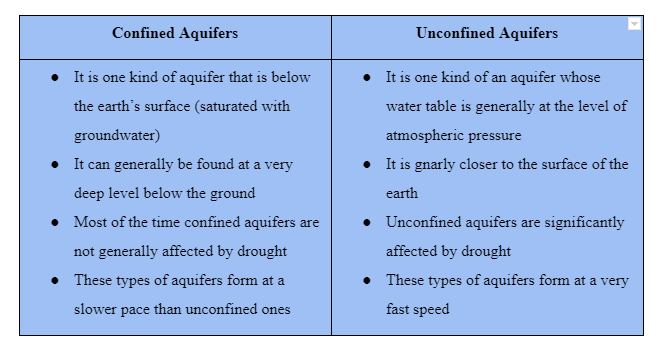Introduction
An aquifer is known as a body of porous sediment or rock that is filled with groundwater. The process by which groundwater enters the aquifer is the method by which precipitation drips into the soil. Through springs and well it can move through resurface and aquifer. An example of a water-well system that is integrated within a house shows that this is one of the most important sources of groundwater. There are two types of aquifers which are confined and unconfined. Unconfined aquifers are generally those kinds of aquifers where rock is open at the ground surface and groundwater can directly be recharged by snowmelt or rainfall. Confined aquifers are generally those kinds of aquifers where there can be observed thick layers of deposits such as clay or mud, and these layers confine the groundwater from the surface of the earth.
Unconfined Aquifers
An unconfined aquifer is a water body that is formed by groundwater. Most of the groundwater in an unconfined aquifer is the collection of groundwater from either rainwater or the melting of snow. Furthermore, unconfined aquifers can be formed from the upper surface of the earth or the atmosphere too. However, they can be problematic as atmospheric pressure plays a significant role in terms of fluctuating them. In regards to the “trenchless technology,” an unconfined aquifer can create challenges in “trenchless construction” in various methods.
Difference between “Confined and Unconfined Aquifers”

Steady Flow in “Confined and Unconfined Aquifer”
Under the conditions of a steady flow in both the “Confined and Unconfined Aquifer”, the level of groundwater (level of groundwater in the unconfined aquifer and piezometric level of groundwater in the confined aquifer) remain steady or constant over the time. It needs to be highlighted that when the rate of discharge of groundwater is equal to the rate of recharge of groundwater, then there can be observed a steady flow in both confined and unconfined aquifers. There can be observed a linear slope or gradient to the “piezometric surface” if there is a steady flow in a confined aquifer.
Unsteady Flowin Confined and Unconfined Aquifer
In both the confined and unconfined aquifer, an unsteady flow refers to the condition where the quantity of groundwater flowing per second does not remain always constant. Furthermore, from various researches, it can be observed that an unsteady flow is considered as the “transient phenomenon”. As time passes the unsteady flow in both the confined and unconfined aquifer can become zero or steady flow. On the other hand, in this type of flow, the rate of recharge of groundwater is not equal to the rate of groundwater discharge.
Conclusions
After conducting the study, in a nutshell, it can be said that aquifers are one of the most important aspects that play a significant role in terms of maintaining the level of groundwater, as without groundwater there will be a huge scarcity of clean drinking water. It is hoped that this study will be helpful to present a clear understanding of the topic.
 Profile
Profile Settings
Settings Refer your friends
Refer your friends Sign out
Sign out






